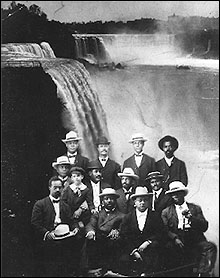Archives
Event to mark centennial of Niagara Movement
By PATRICIA DONOVAN
Contributing Editor
The Department of African American Studies will sponsor a celebration of the 100th anniversary of the founding of the Niagara Movement with an event to be held at 11 a.m. on Saturday.

Founding members of the Niagara Movement: Top row, left to right: H. A. Thompson, New York; Alonzo F. Herndon, Georgia; unidentified; unidentified. Second row, left to right: Fred McGhee, Minnesota; unidentified boy; J. Max Barber, Illinois; W.E.B. Du Bois, Atlanta; Robert Bonner, Massachusetts; Bottom Row: left to right: Henry L. Baily, Washington, D.C.; Clement G. Morgan, Massachusetts; W.H.H. Hart, Washington, D.C.; and B.S. Smith, Kansas.
Most Buffalonians have no idea that the influential National Association for the Advancement of Colored People (NAACP) is rooted in the work of pioneering civic, religious, education and business leaders of Buffalo's African-American community.
Those leaders set the stage for the founding of the Niagara Movement, which blazed the trail for civil justice for African Americans in the 20th century.
The celebration will take place at 521 Michigan St., site of the home of Mary Barnett Talbot (1866-1923), a nationally distinguished figure in the movement for social justice for African Americans and women, and founding member of the both the Niagara Movement and the NAACP.
During the event, stakeholders in Buffalo's African-American community will read the Niagara Movement's 1905 "Declaration of Principles" and present a "Declaration of Principles" for 2005.
Re-enactors representing historic figures associated with the founding of the Niagara Movement will mingle with the crowd. Among the historic personages they will represent are Talbert; the Rev. J. Edward Nash, pastor of the Michigan Avenue Baptist Church who was involved in the efforts to bring branches of the Urban League and the NAACP to Buffalo; and Amelia Anderson, a founder of the Buffalo branch of the NAACP who later served as the chapter's secretary and president.
Those on hand for the event will include Lillian Williams, associate professor and chair of the Department of African American Studies; Joseph Gardella, professor of chemistry and associate dean for external relations for the College of Arts and Sciences, representing the Environmental Justice Coalition; Mary Gresham, vice president for public service and urban affairs and dean of the Graduate School of Education; historian Carl Nightingale, director of the UB Seminar on Racial Justice; and Ewa Ziarek, Park Professor of Comparative Literature in the CAS, representing the university's Humanities Council.
Also present will be representatives of the national office of the NAACP, the Association for the Study of African American Life and History, the National African American Women's Leadership Institute, Niagara County Legislator Renae Kimble and a representative of State Sen. Byron Brown.
Also, Laurene Buckley, director of the Castellani Art Center at Niagara University; Monroe Fordham of the Regional History Center at Buffalo State College; Madeline Scott, president of Afro-American Historical Association of the Niagara Frontier; and Barbara Nevergold and Peggy Brooks Bertram, representing the Uncrowned Queens Project.
The Niagara Movement had its roots in a secret meeting of 31 business, civic and religious leaders, including sociologist and activist W.E.B. Du Bois, held in February 1905 in the Buffalo home of Mary Burnett Talbot.
In July of that year, these and other African-American scholars, intellectuals, writers and activists met in Niagara Falls, Ontario, to formally establish the Niagara Movement and to issue its "Declaration of Principles," a plan for the aggressive promotion of manhood suffrage and equal economic and educational opportunities; an end to segregation, and the establishment of full civil rights.
The group famously denounced Booker T. Washington's policy of accommodating the oppressive white hegemony as set forth in his "Atlanta Compromise" speech in 1895.
Led by Du Bois, the movement held annual conferences in Buffalo and Harper's Ferry and although short-lived, was very influential and, as they hoped, "unleashed a mighty current of protest across the land." The group lasted until the establishment of the NAACP in 1909 by many of the founders of the Niagara Movement.
